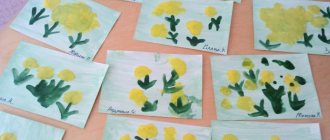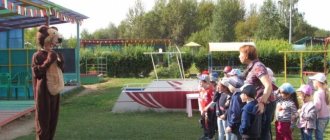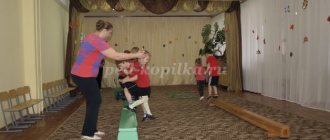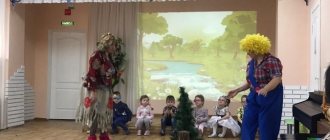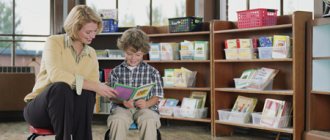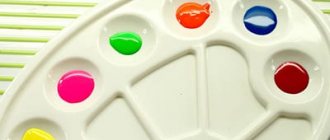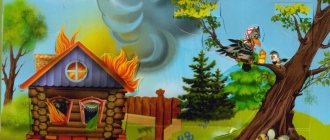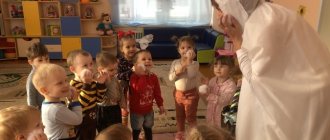lesson notes for the math club in the middle group
Dispensing: circles 5 pcs., squares 5 pcs., “ice tracks” made of cardboard of different lengths and widths (2 pcs.), “snowballs” of different sizes (2 pcs.)
Progress of the lesson.
1.Game meeting between smart guys and smart girls. 2 teams - boys and girls. Teams take turns counting out 5 cars and 4 dolls and placing them on the table. Specify the quantity. Discuss familiar methods of comparison (overlay and application)." 5 cars and 4 dolls - compare which is more. 4 dolls and 5 cars - compare. which is less."
2. Similar work is carried out with handouts (circles and squares). They equalize using one of the following methods.
Physical education minute.
Game "Nose, ear".
3. Game exercise “Arrange the figures.” Each team places in one basket -
balls, in the other - cubes. Specify the names of the figures.
4. Comparison of “ice tracks” in length and width, conclusion: one track is large, the other is small. The smart guys roll a big “snowball” along the big path, and the smart ones roll a small “snowball” along the small path.
Award for both teams.
Lesson 17
Goal: Practice counting sounds within 5. Practice counting objects by touch within 5. Strengthen ideas about the meaning of words yesterday, today, tomorrow. Learn to compare 3 objects by width, arrange them in descending and ascending order, denote the results of comparison with the words: wide, narrower, narrowest, narrow, wider. The widest.
Materials: flannelgraph, 3 scarves of the same color, the same length and different widths, 3 rectangles of the same color, the same length and different widths.
Handout: cards with buttons in bags (1-5 buttons on cards), sets of cards with circles (1-5 circles on cards), plot pictures depicting children playing winter games (4-5 pieces each), glockenspiel.
Progress of the lesson.
1. Make a riddle about winter. Remember the items of winter clothing. On the flannelgraph there are scarves of the same color of the same length and different widths. Determine how they are similar and how they differ (by the method of overlay and application). The concepts wide, narrow, and narrowest are fixed.
2.Game situation “Going down (ascending) the steps.” Rectangles are shown. Determine how they are similar and how they differ. Arrange them in a ladder (starting from the narrowest to the widest). The concepts narrow, wider, and widest are fixed.
Physical education 1, 2, 3, 4, 5
The little bunny began to jump.
It's a lot of fun for the little bunny to jump.
He jumped 10 times.
3. Game exercise “Show the same amount.” The bag contains a card with a certain number of buttons. The child counts the buttons by touch and shows a card with the same number of circles. He explains why he showed this particular card. Children take out a card with buttons from the bag and check the correctness of the answer. The exercise is repeated 2-3 times.
Club "Entertaining Mathematics" in the middle group. (Age 4-5 years).
Explanatory note
The formation and development of mathematical concepts in preschoolers is the basis for the intellectual development of children and contributes to the general mental education of a preschool child.
Organization of the “Entertaining Mathematics” circle provides an opportunity to develop cognitive activity, interest in mathematics, and develop logical thinking. The circle is held once a week, 20 minutes, in the afternoon. The peculiarity of this work is that this activity represents a system of exciting games and exercises for children with numbers and geometric shapes, thereby allowing them to qualitatively prepare children for school. I organize activities based on the interests, needs and inclinations of children, thereby stimulating children’s desire to engage in mathematics. When conducting group work, I pay special attention to the development of logical forms of thinking.
Purpose of circle work:
To develop children's intellectual abilities, cognitive activity, interest in mathematics and the desire to creatively apply acquired knowledge.
The main tasks of the circle:
- development of logical thinking and basic mental operations;
- development of mathematical abilities and aptitudes;
- quality preparation of the child for school;
- development of personal qualities and skills of self-control and self-esteem;
Sections of the work program:
1. “Quantity and counting”
- Goal: to develop independence, activity, introduce counting within 10, practice solving simple addition and subtraction problems, consolidate understanding of the relationships between numbers, develop mental processes: attention, memory, logical forms of thinking.
2. “Introduction to geometric shapes”
- Goal: to consolidate ideas about geometric shapes and their properties, to develop the ability to classify geometric shapes according to certain characteristics, visual-spatial perception, and logical thinking.
3. “Determination of quantity”
- Goal: to develop the ability to compare the length, mass (weight), size of objects, compare the results obtained, draw conclusions and conclusions.
4. “Orientation in time, space, on a plane”
- Develop orientation on a plane (sheet of paper), in space, a sense of time; introduce clocks, days of the week, names of months; give ideas about the sequence of days of the week, months, year.
5. “Solving logical problems”
- Develop in children methods of mental activity (analysis, comparison, classification, generalization).
Requirements for the level of student preparation
Upon completion of training, students should know:
• non-standard methods for solving various mathematical problems;
• logical techniques used in solving problems;
• history of the development of mathematical science.
Upon completion of training, students should be able to:
• reason when solving logical problems, problems of ingenuity, problems of erudition and intuition;
• systematize data in the form of tables when solving problems, when composing mathematical crosswords, charades and puzzles;
• apply non-standard methods when solving software problems.
Methodological support.
A methodological feature of the presentation of educational materials in circle classes is such a presentation in which new content is studied through problems. The task-based teaching method is based on the following didactic principles:
• the best way to teach students, giving them conscious and lasting knowledge and ensuring their simultaneous mental development, is that students are given sequentially feasible theoretical and practical tasks, one after another, the solution of which gives them new knowledge;
• with the help of tasks that are sequentially related to each other, you can familiarize students with even quite complex mathematical theories;
• mastering educational material through sequential problem solving occurs in a single process of acquiring new knowledge and its immediate application, which contributes to the development of cognitive independence and creative activity of students.
Much attention is paid to students' mastery of mathematical methods for finding solutions, logical reasoning, construction and study of mathematical models.
To maintain students' interest in the material being studied and their activity throughout the entire lesson, it is necessary to use didactic games - a modern and recognized method of teaching and upbringing, which has educational, developmental and nurturing functions that operate in organic unity. In addition, in the mathematics circle classes it is necessary to create an “atmosphere” of free exchange of opinions and active discussion.
Regarding learning technologies, i.e. a series (system) of techniques organized in a certain way, then the most adequate are
- problem-based developmental education;
- adapted training;
- individualization and differentiation of training;
- information Technology.
When consolidating the material, improving knowledge, skills and abilities, it is advisable to practice independent work of schoolchildren.
The use of modern educational technologies allows you to combine all modes of work: individual, paired, group, collective.
In addition, the effectiveness of the course organization is facilitated by the use of various forms of conducting classes:
- heuristic conversation;
- workshop;
- intellectual game;
— discussion;
- creative work.
Reasonable homework assignments are required. Homework consists not only of repeating the topic of the lesson, but also of independently studying literature recommended by the teacher.
Forms of control:
Assessment of educational achievements in circle classes should differ from the usual assessment system in the classroom. The following forms of control can be distinguished:
— messages and reports (mini);
— testing using tasks from the Kangaroo mathematical competition
— creative report (in any form of the students’ choice);
- various exercises in oral and written form.
It is also possible for students to conduct reflection themselves.
Aids used: Dienesh blocks, Cuisenaire sticks, problems in verse, counting sticks, mathematical constructor, numbers, visual aids, didactic games, lotto.
MAGAZINE Preschooler.RF
Summary of a mathematics lesson in the middle group “Entertaining mathematics”Teacher of MBDOU-kindergarten No. 362 Temchenko Irina Borisovna, Yekaterinburg, Sverdlovsk region.
Tasks:
- strengthen children's ability to count to 5;
- form an idea of equality and inequality of 2 groups of objects based on counting;
- consolidate the ability to distinguish between circles, squares, triangles, and rectangles.
Visual material: toys (5 pcs.), doll cups (5 pcs.), track, geometric shapes, counting sticks, plasticine.
Progress of the lesson
1 part. Game situation “Visiting the Bunny” .
The teacher tells the children that toys came to visit the bunny (plants the animals). Finds out from the children what needs to be done to find out how many guests have arrived? Children's answers: . ”
The teacher counts together with the children and makes a generalizing gesture and clarifies with the children: “How many guests have come?”
Children: «4».
How many guests are there at the table, along with the bunny?
Children: 5
2. The teacher offers to treat the guests to tea and put a cup for everyone. One child places cups in front of each toy. And he counts how many cups he placed (5).
The teacher clarifies: “4 guests and 5 cups - compare, which is more? (5 animals are more than 4 cups). Compare 4 cups and 5 animals, which is smaller? 4 cups are less than 5 animals). How can we make sure that there is an equal number of guests and cups?”
Children discuss two ways to equalize objects: by adding or subtracting one object. The called child equalizes objects in one of the following ways.
“How many guests and cups are there?” - the teacher finds out.
Then he restores the inequality and asks another child to establish equality in a different way. The teacher clarifies the formation of the number 5.
3. Educator: Do I hear some noise? Look at the window! (the teacher removes the turtle)
Educator: Yes, there is an envelope here! It's a wonder where he came from! Let's open it and read it.
I'm an evil barmaley, I stole your turtle! And you will never see her again!
Educator: Don't worry, guys.
I have a magic path, now I’ll spread it and the turtle can escape!
(The teacher lays out the path)
What's happened? Someone ruined the path! Yes, here is the letter again, let’s read: It’s me, the evil Barmaley, you will never be able to fix the path!
Educator: Guys, what are we going to do? (children fix, the teacher calls the willing children in turn, the children name the geometric figure and put it in place)
4. Educator: We did it! A new envelope has arrived! I'm reading: I need to play the game the numbers got lost. Guys, we can do it. (cards with numbers, distribute to children)
Our numbers are spinning, spinning, getting lost
Come on, help the figure, find a match for her as soon as possible! (children find the same numbers and name them)
Educator: Great! We did it! To continue completing tasks, we will conduct a physical education session.
5. Physical education minute
The cubs lived in the thicket, twisting their heads like this, like this, (circular movements with their heads) twisting their heads
The cubs were looking for honey. They rocked the tree together (raise your arms up and bend to the right and left) Like this, like this, together they rocked the tree,
And then they walked (walking like a bear) And they drank water from the river Like this, like this And they drank water from the river (torso bend forward)
And then they danced (springs with the body turning left and right) Raised their paws higher (jumping, clapping their hands at the top) Like this, like this, Raised their paws higher!
6. Next task: Look around and find in the group something that has a round shape, then triangular, square, rectangular.
7. The teacher reads Barmaley’s task to play the game “find your place”
(call 5 children, put them out of order, children need to stand up correctly on their own)
8. Barmaley was seriously angry! He wants a physical education session. Skok-skok skok-skok The bunny jumped onto a stump.
He beats the drum loudly and invites you to play leapfrog. The hare is sitting cold, needs to warm his paws
Paws up, paws down, pull yourself up on your toes. We put our paws on their sides. On their toes, hop, hop, hop.
And then squat down so that your paws don’t freeze.
Educator: And now, the next task from Barmaley! The kids need to add up numbers from counting sticks or mold them from plasticine. Choose what you will do and get to work quickly.
(Children sit at different tables, if desired)
Educator: Great! Guys! We've got the numbers, let each of you tell us what his number is! Guys! Look, the turtle is back. The friends were delighted and began to dance. (Everyone is dancing merrily)
| Next > |
